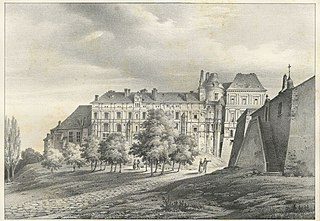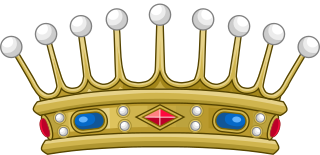Related Research Articles

The Royal Château of Blois, is located in the city center of Blois, Loir-et-Cher, in the Loire Valley, France. In addition to have been the residence of the Counts of Blois and some French Kings, Joan of Arc also went there by 1429 to be blessed by the Archbishop of Reims before departing with her army to drive against the English, who conquered Orléans the previous year.

The Château de Chaumont, officially Château de Chaumont-sur-Loire, is a castle (château) in Chaumont-sur-Loire, Centre-Val de Loire, France. The castle was founded in the 10th century by Odo I, Count of Blois. After Pierre d'Amboise rebelled against Louis XI, the king ordered the castle's destruction. Later in the 15th century Château de Chaumont was rebuilt by Charles I d'Amboise. Protected as a monument historique since 1840, the château was given into state ownership in 1938 and is now open to the public.

Blois is a commune and the capital city of Loir-et-Cher department, in Centre-Val de Loire, France, on the banks of the lower Loire river between Orléans and Tours.

Augustin Thierry was a French historian. Although originally a follower of Henri de Saint-Simon, he later developed his own approach to history. A committed liberal, his approach to history often introduced a romantic interpretation, although he did engage in research of primary sources. He nevertheless was recognised as a significant historian of the evolution of communal governance.

François Just Marie Raynouard was a French dramatist and linguist.

The Jardin du Luxembourg, known in English as the Luxembourg Garden, colloquially referred to as the Jardin du Sénat, is located in the 6th arrondissement of Paris, France. Creation of the garden began in 1612 when Marie de' Medici, the widow of King Henry IV, constructed the Luxembourg Palace as her new residence. The garden today is owned by the French Senate, which meets in the Palace. It covers 23 hectares and is known for its lawns, tree-lined promenades, tennis courts, flowerbeds, model sailboats on its octagonal Grand Bassin, as well as picturesque Medici Fountain, built in 1620. The name Luxembourg comes from the Latin Mons Lucotitius, the name of the hill where the garden is located.

Charles of Blois-Châtillon, nicknamed "the Saint", was the legalist Duke of Brittany from 1341 until his death, via his marriage to Joan, Duchess of Brittany and Countess of Penthièvre, holding the title against the claims of John of Montfort. The cause of his possible canonization was the subject of a good deal of political maneuvering on the part of his cousin, Charles V of France, who endorsed it, and his rival, Montfort, who opposed it. The cause fell dormant after Pope Gregory XI left Avignon in 1376, but was revived in 1894. Charles of Blois was beatified in 1904.

During the Middle Ages, the counts of Blois were among the most powerful vassals of the King of France.

The Wall of the Ferme générale was commissioned by Antoine Lavoisier and built between 1784 and 1791 by the Ferme générale, the corporation of tax farmers. It was one of the several city walls of Paris built between the early Middle Ages and the mid 19th century. It was 24 kilometers long and roughly followed the route now occupied by line 2 and line 6 of the Métro. It crossed the districts of the Place de l'Étoile, Batignolles, Pigalle, Belleville, Nation, the Place d'Italie, Denfert-Rochereau, Montparnasse and the Trocadéro.

Ronde-bosse, en ronde bosse or encrusted enamel is an enamelling technique developed in France in the late 14th century that produces small three-dimensional figures, or reliefs, largely or entirely covered in enamel. The new method involved the partial concealment of the underlying gold, or sometimes silver, from which the figure was formed. It differs from older techniques which all produced only enamel on a flat or curved surface, and mostly, like champlevé, normally used non-precious metals, such as copper, which were gilded to look like gold. In the technique of enamel en ronde-bosse small figures are created in gold or silver and their surfaces lightly roughened to provide a key for the enamel, which is applied as a paste and fired. In places the framework may only be wire.

La Barben is a commune in the Bouches-du-Rhône department in the Provence-Alpes-Côte d'Azur region of southern France.

The Roman Catholic Diocese of Blois is a diocese of the Latin Rite of the Roman Catholic Church in France. The diocese lies in western France, and encompasses the department of Loir-et-Cher. Since 2002 it has been a suffragan of the Archdiocese of Tours.

Jacques Félix Duban was a French architect, the contemporary of Jacques Ignace Hittorff and Henri Labrouste.

The House of Beauharnais is a French noble family. It is now headed by the Duke of Leuchtenberg, descendant in male line of Eugène de Beauharnais.
Louis Dejean, was a French sculptor and engraver. He worked in the workshop of Gaston Schnegg, along with Antoine Bourdelle, Charles Despiau, Robert Wlérick, Léon-Ernest Drivier, François Pompon, Alfred Jean Halou, Charles Malfray, Auguste de Niederhausern, Henry Arnold, Jane Poupelet and Yvonne Serruys.

Léon-Ernest Drivier, was a French illustrator and sculptor.

The Holy Thorn Reliquary was probably created in the 1390s in Paris for John, Duke of Berry, to house a relic of the Crown of Thorns. The reliquary was bequeathed to the British Museum in 1898 by Ferdinand de Rothschild as part of the Waddesdon Bequest. It is one of a small number of major goldsmiths' works or joyaux that survive from the extravagant world of the courts of the Valois royal family around 1400. It is made of gold, lavishly decorated with jewels and pearls, and uses the technique of enamelling en ronde bosse, or "in the round", which had been recently developed when the reliquary was made, to create a total of 28 three-dimensional figures, mostly in white enamel.

Edgar Boutry (1857–1938) was a French sculptor who executed several public statues and monuments and worked on several Monuments aux Morts. He also ran the Écoles académiques lilloises.

Constant Ambroise Roux was a French sculptor.

Pierre-Marie Poisson was born in Niort on 19 November 1876 and died in Paris on 11 January 1953. He was a French sculptor and medallist.
References
- ↑ "Gaston Schnegg et le monument de Quinsac en Gironde", 19 November 2007 Moulindelangladure.typepad.fr Retrieved June 4, 2009
- ↑ Base Palissy : Ronde-bosse (statuette) : jeune femme agenouillée , Ministère français de la Culture. (in French)